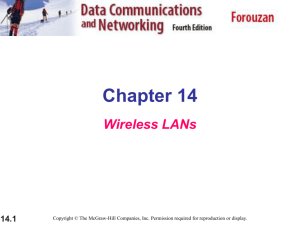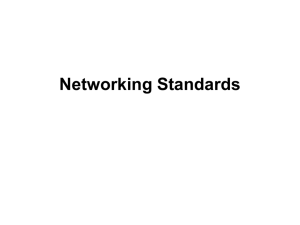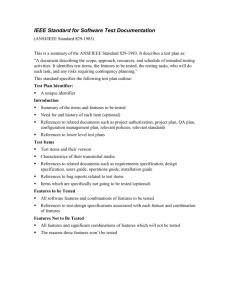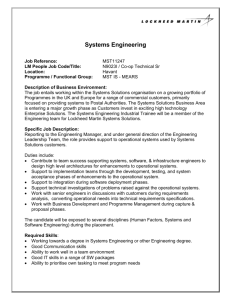STANDARDS
advertisement
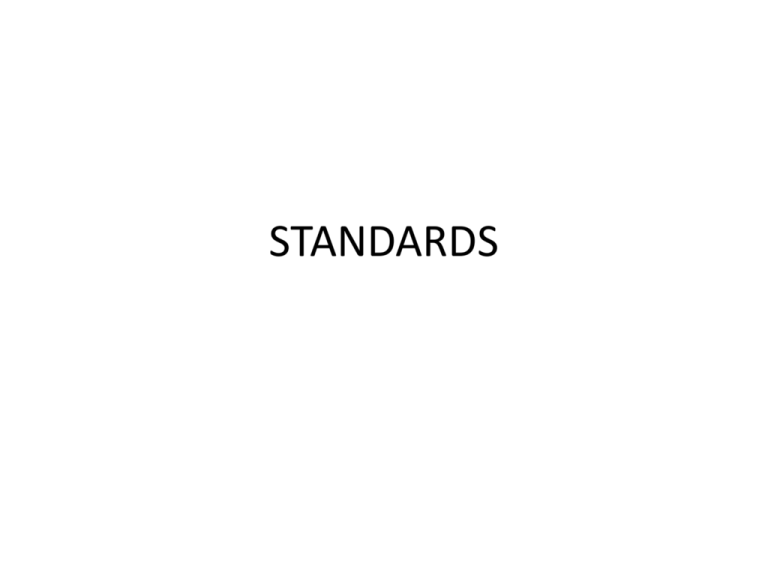
STANDARDS Standards • • • • What are they? How are they created? What do they look like? Why are they important to you? Attendance and Assignment • On a piece of paper with your name on it-• List two standards that are related to your team’s project. • What type of standard are the two standards you listed? Are you all familiar with these standards? • TIA-232-F Interface Between Data Terminal Equipment and Data Circuit-Terminating Equipment Employing Serial Binary Data Interchange • IEEE 802.11 • IEEE 802.15.1 Are you all familiar with these Standards? • RS-232 • WIFI • Bluetooth Are you all familiar with these standards? • TIA-232-F Interface Between Data Terminal Equipment and Data Circuit-Terminating Equipment Employing Serial Binary Data Interchange (RS-232) • IEEE 802.11 (WIFI) • IEEE 802.15.1 (Bluetooth) What is a Standard? • A Standard is a published document that establishes specifications and procedures designed to maximize the reliability and usability of materials, products, methods, and/or services that people use. • Needed for product functionality, compatibility, interoperability and customer safety. • Standards are often building blocks for design of products. What does a Standards Document look like? • Look at Bluetooth Standard Who develops Standards? • Accredited standards that are developed under the oversight of a not-for-profit organization whose stated purpose or charter is the “public good” are considered by some to be the only “true” Standards in the marketplace. Examples of such an accreditation process in the United States is the American National Standards Institute (ANSI), which accredits SDOs (Standards Development Organizations), e.g., IEEE, INCITS, TIA, and ATIS. • A European example is the European Union (EU) which oversees standards development in the EU, under such groups as ETSI, CEN and CENELEC. • Internationally, the International Telecommunications Union operates as a "special agency" of the United Nations. The International Standards Organization (ISO) and the International Electrotechnology Commission (IEC) are two other examples of international organizations. What are the types of standards? • • • • • • What is a consensus standard? What is a proprietary standard? How are consensus standards developed? What is an accredited standards process? Who is ANSI, IEEE, ISO, IEC? What is a de facto standard? Watch a short video from ANSI? • http://www.standardslearn.org/Presentations /IntroToStandards/index.htm Slide 4 to Slide 19 Example Standards • ANSI Z87.1-2003 (Safety Glasses Standard) • IEEE 802.15.1 (BlueTooth Standard) • VHS vs Beta (Proprietary Standards) “Accredited Standards” • Historically, standards development carried out under an accreditation process has been the traditional measure and requirement for a technical agreement to be considered a standard. This draws in part from the fact that, in the USA, ANSI carries out a "board of standards review" process on every standard produced as an American National Standard. • Further, ANSI carries out periodic audits of all accredited standards development organizations (like IEEE) every 5 years to assure that the standards developer is operating in a fair and non-discriminatory manner and satisfies through demonstrated actions: consensus, openness, transparency, balance of interests, due process and rights to appeal. Open Source Standards Creation • Market successes have occurred without the "benefit" of an accredited standard. One such example is the Internet suite of standards which were developed under an open process, sometimes referred to as an "open source process" now under the aegis of the Internet Engineering Task Force (IETF). The Internet stands as one clear example that highly valuable and widely accepted technology agreements can come from sources other than the traditional/accredited standards developers. The important point: engineers and technologists must know if and how standards affect or can affect their practice/employment of engineering and technology. • In the case of signaling technology necessary to interconnect national and international telephony networks, formal/accredited standards were developed at both the national (ANSI in USA, ETSI in Europe) and internationals levels (ITU-T). These current standards are known of as Signaling System 7 Standards. Voluntary Standard • A voluntary standard may incorporate patented technologies as an element or as the basis of its technology. In these cases the patent owner must agree to license the patents to all implementers of the standards under fair, Reasonable and Non-Discriminatory conditions, sometimes referred to as RaND conditions. The same can apply for licenses for copyright if that should apply, such as may be the case for computer code. • Example: Bluetooth is managed by the Bluetooth Special Interest Group (SIG), which has more than 20,000 member companies in the areas of telecommunication, computing, networking, and consumer electronics.[5] Bluetooth was standardized as IEEE 802.15.1, but the standard is no longer maintained. The SIG oversees the development of the specification, manages the qualification program, and protects the trademarks.[6] To be marketed as a Bluetooth device, it must be qualified to standards defined by the SIG.[7] A network of patents is required to implement the technology, which is licensed only for that qualifying device. Proprietary Standards • Proprietary standards are owned by one or more companies and are normally protected by one or more of the following: patents, copyrights, and trade-secrets. • Standards that are developed behind corporate closed doors will find themselves implemented in the marketplace only by that corporation or by that corporation and others that are licensed or otherwise allowed by the owner corporation. There are many examples of proprietary standards, some have been successful in the marketplace, others have not. Proprietary Standard: Example • The development of proprietary protocols controlling the storage and retrieval of video information on magnetic tapes took two forms in the late 1960s. • VHS and Beta, were owned by different companies, neither of which decided to work for an accredited standard. Each went into the marketplace simply on the value of the technology and the recognition of their corporate name. • In the case of VHS, the owner decided it would license others to manufacture record and playback devices based on the VHS technology. • The Beta company decided to make a try for market dominance on a go it alone basis. • This resulted in the VHS being incorporated in more products, and thus it won a broader market acceptance, ultimately totally displacing the Beta technology. • Some have said the Beta technology was superior, yet the VHS won the market battle by becoming a de facto standard leveraged by multiple sources of supply. Mandatory Standards • Examples of mandatory standards in the USA are standards addressing the use of radio spectrum which is mandated under law by the Federal Communications Commission (FCC). • Another example is the case where a state or local municipality produces a "code" covering residential and commercial electrical wiring and makes reference to a voluntary standard such as the National Electrical Code, which is a voluntary standard despite the use of the word "code" in its title. Compliance • Compliance with standards must be proven via: – – – – – Required or commonly recognized testing (which is also standardized) Design process testing Manufacturing testing for quality and consistency Customer acceptance testing Ongoing compliance testing • The only definitive way to know if a product performs according to standards is to perform some type of test or tests. These tests and measurement methods have to be standardized or there will be chaos with no repeatability or reproducibility of the compliance measurement. The good news is that most of these critical tests have been standardized for some time, but they continue to be amended and updated. Design with compliance in mind • Most modern digital devices (i.e. those devices which are run by a microprocessor or are in fact a computer or computing device) are regulated as to limit the RF interference potential from these digital devices. • But how does one know that there will be, for example, no interference? It is relatively simple to determine those portions of a product design that are applicable to the standard. But to get a metric of how they meet the standard, limited testing is needed. • Using design process testing, this can be done almost from the start—for example, by the way in which components are selected, how they are laid out on a printed wiring board, and how they connect to adjacent circuit packs and up to frame level. Even after the design is nearing completion and is ready to be released to manufacturing, there needs to be a final test (manufacturing testing for quality and consistency) using standard test techniques to show with confidence that the product meets regulatory limits and compliance. Standards are used in Product Design • The product will not succeed unless the customer is satisfied with the product and sees the labels on the product that shows that it meets various standards for safety, RF interference, interoperability, etc. • The customer also wants the product to continue to operate as intended and for a reasonably long period of time, even when repairs are needed. Repairs should not defeat or affect all the work done to meet the appropriate standards in the first place. • Furthermore, manufacturing has to continue to show ongoing compliance so that the first product and the last product off the production line continue to meet the standards under which the product was designed. • Finally, standards even apply at the end of the useful life cycle of the product or when it is tossed away as "out of style" or “obsolete.” Many countries are imposing recycling standards and requirements that must be addressed during product development. Liability and Standards • In a legal sense, engineers are expected to “act as prudently and carefully as other reasonable engineers would have acted under the same or substantially similar circumstances.” • How do you know how other engineers would “act”. A very important way is to follow the standards developed by other engineers. References • IEEE Standards website • ANSI Standards website Attendance and Assignment • On a piece of paper with your name on it-• List two standards that are related to your team’s project. • What type of standard are the two standards you listed?
